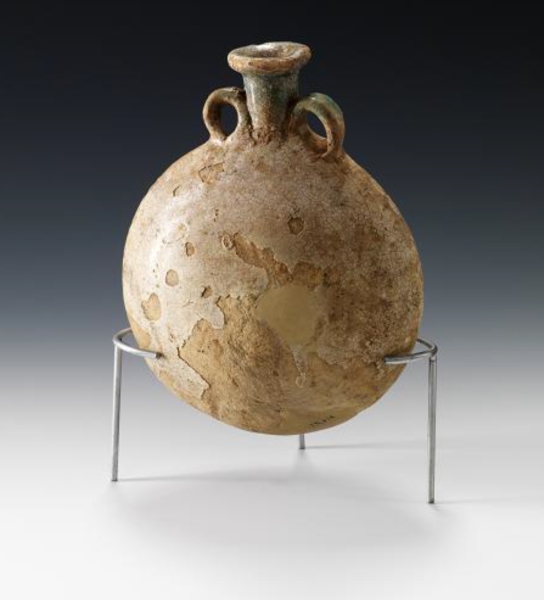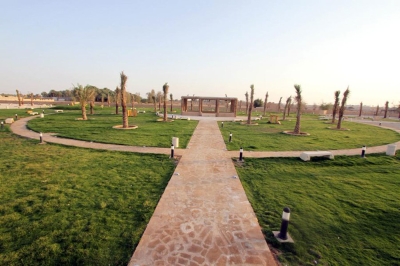
The Ceramic Flask is an ancient round flask, shaped like the back of a turtle. It was discovered in the archeological Qaryat al-Faw, the home of al-Faw civilization in the Arabian Peninsula. The village is located in the region where Wadi ad-Dawasir intersects with Tuwaiq Mountain range, near the mouth of a channel called al-Faw, in Wadi ad-Dawasir Governorate, in Riyadh Province of the Kingdom of Saudi Arabia.
Description of the ceramic flask
The ceramic flask was crafted from a pure yellow clay paste. It features a tall, narrow neck that ends with a thick, outwardly protruding rim. The flask has two ear-shaped handles attached to the shoulder and the lower part of the neck. Its base is pointed, serving as an extension of the body. The exterior surface shows remnants of a green glaze layer that has eroded to a white color in places, with patches of oxidized firing marks. It was wheel-made and exhibits high durability.
Measurements of the ceramic flask
Body diameter: Twenty cm.
Neck length: Six cm.
Mouth diameter: 5.5 cm.
Flask's height: Twenty-six cm.
Flask's thickness: Eleven cm.
History of the ceramic flask
This ceramic flask dates back to the period between the third century BCE and the third century BC. It was used for storing liquids.
The ceramic flask is preserved at the Archaeology Department Museum at King Saud University in Riyadh and is registered under number 14 F 22.
The discovery of the ceramic flask is part of the results of archaeological surveys and excavations conducted by the Antiquities and Museums Sector in Saudi Arabia over the past years. It is among numerous findings by Saudi archaeologists, scientific missions, and specialized research teams.
The ceramic flask at the Louvre Museum
The ceramic flask is one of the artifacts selected to participate in the Saudi Archaeological Masterpieces Through the Ages Exhibition, held at the Louvre Museum in the French capital, Paris, in 2010. The exhibition included three hundred pieces made of various materials and spanning different periods. These are original artifacts from various regions of Saudi Arabia, categorized chronologically into three groups: from prehistoric periods, from pre-Islamic periods, and from Islamic periods.
Significance of the ceramic flask
This style of ceramic flasks and its design indicate their use for storing liquids. The surface treatment, including glazing, suggests that it was applied to prevent liquid seepage.
Related quizzes
Related articles

